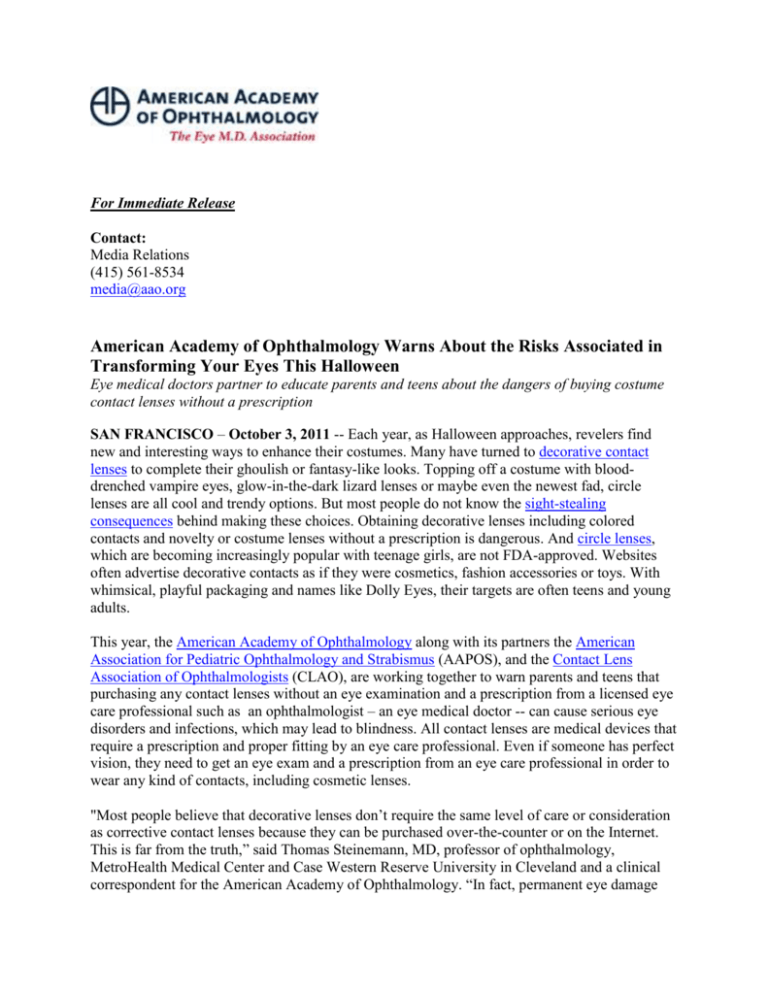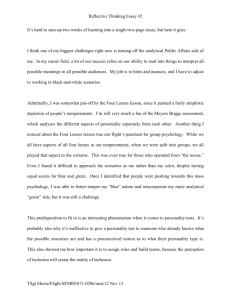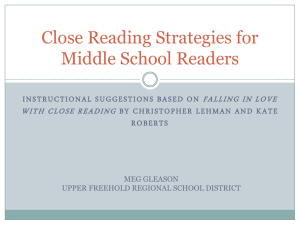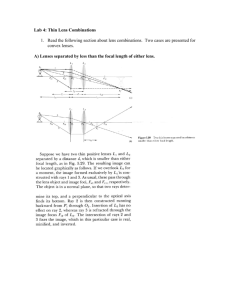Audio News Release Script
advertisement

For Immediate Release Contact: Media Relations (415) 561-8534 media@aao.org American Academy of Ophthalmology Warns About the Risks Associated in Transforming Your Eyes This Halloween Eye medical doctors partner to educate parents and teens about the dangers of buying costume contact lenses without a prescription SAN FRANCISCO – October 3, 2011 -- Each year, as Halloween approaches, revelers find new and interesting ways to enhance their costumes. Many have turned to decorative contact lenses to complete their ghoulish or fantasy-like looks. Topping off a costume with blooddrenched vampire eyes, glow-in-the-dark lizard lenses or maybe even the newest fad, circle lenses are all cool and trendy options. But most people do not know the sight-stealing consequences behind making these choices. Obtaining decorative lenses including colored contacts and novelty or costume lenses without a prescription is dangerous. And circle lenses, which are becoming increasingly popular with teenage girls, are not FDA-approved. Websites often advertise decorative contacts as if they were cosmetics, fashion accessories or toys. With whimsical, playful packaging and names like Dolly Eyes, their targets are often teens and young adults. This year, the American Academy of Ophthalmology along with its partners the American Association for Pediatric Ophthalmology and Strabismus (AAPOS), and the Contact Lens Association of Ophthalmologists (CLAO), are working together to warn parents and teens that purchasing any contact lenses without an eye examination and a prescription from a licensed eye care professional such as an ophthalmologist – an eye medical doctor -- can cause serious eye disorders and infections, which may lead to blindness. All contact lenses are medical devices that require a prescription and proper fitting by an eye care professional. Even if someone has perfect vision, they need to get an eye exam and a prescription from an eye care professional in order to wear any kind of contacts, including cosmetic lenses. "Most people believe that decorative lenses don’t require the same level of care or consideration as corrective contact lenses because they can be purchased over-the-counter or on the Internet. This is far from the truth,‖ said Thomas Steinemann, MD, professor of ophthalmology, MetroHealth Medical Center and Case Western Reserve University in Cleveland and a clinical correspondent for the American Academy of Ophthalmology. ―In fact, permanent eye damage can occur from using over-the-counter lenses. We want to discourage all consumers, especially teens, from buying contact lenses in beauty salons, novelty shops or in Halloween stores.‖ In 2005, a federal law was passed that classified all contact lenses as medical devices and restricted their distribution to licensed eye care professionals. Illegal sale of contacts can result in civil penalties of up to $11,000 per violation. Consumers should only buy decorative contact lenses from an eye care professional or a seller who asks for a prescription. While Halloween is a popular time for people to use decorative contact lenses, it’s important to take proper care year-round. To protect the eyes, an eye care professional measures each eye in order to properly fit contacts for the patient. There is no such thing as ―one-size-fits-all‖ contact lenses. Contacts that are not properly fitted may scratch the eye or cause blood vessels to grow into the cornea. Additionally, the eye care professional instructs the patient on appropriate contact lens care. Contacts that are not cleaned and disinfected increase the risk of eye infection. Not everyone is a good candidate for contacts (prescription or decorative lenses). People who have: frequent eye infections, severe allergies, dry eye that is resistant to treatment, a very dusty work environment, or an inability to handle and care for the lenses may not be suitable candidates for contacts. An eye care professional can assist in helping a patient make a decision that is right for them. Read a patient story and view the American Academy of Ophthalmology’s 30- and 90-second public service announcements. For more information on the safe wearing of decorative lenses as well as regular contacts, visit www.geteyesmart.org About the American Academy of Ophthalmology The American Academy of Ophthalmology is the world’s largest association of eye physicians and surgeons — Eye M.D.s — with more than 30,000 members worldwide. Eye health care is provided by the three ―O’s‖ – ophthalmologists, optometrists, and opticians. It is the ophthalmologist, or Eye M.D., who can treat it all: eye diseases, infections and injuries, and perform eye surgery. For more information, visit www.aao.org. The Academy’s EyeSmart® public education program works to educate the public about the importance of eye health and to empower them to preserve their healthy vision, by providing the most trusted and medically accurate information about eye diseases, conditions and injuries. Visit www.geteyesmart.org to learn more. About the American Association for Pediatric Ophthalmology and Strabismus AAPOS is the American Association for Pediatric Ophthalmology and Strabismus. The organization's goals are to advance the quality of children's eye care, support the training of pediatric ophthalmologists, support research activities in pediatric ophthalmology, and advance the care of adults with strabismus. More information can be found at www.aapos.org. About the Contact Lens Association of Ophthalmologists The Contact Lens Association of Ophthalmologists (CLAO) is a not-for-profit professional association that was founded in 1963 and incorporated in 1964. CLAO’s mission is to advance quality medical eye care for the public by providing comprehensive ophthalmologists and other eye care professionals with education and training in contact lenses and related eye care science. More information can be found at www.clao.org. Note to media: High-resolution images and interviews with local ophthalmologists available upon request. ###







